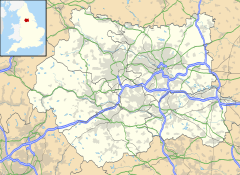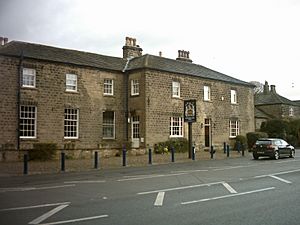Harewood, West Yorkshire facts for kids
Quick facts for kids Harewood |
|
|---|---|
 Harewood House |
|
| Population | 3,734 (2011 census) |
| OS grid reference | SE321449 |
| Civil parish |
|
| Metropolitan borough | |
| Metropolitan county | |
| Region | |
| Country | England |
| Sovereign state | United Kingdom |
| Post town | LEEDS |
| Postcode district | LS17 |
| Dialling code | 0113 |
| Police | West Yorkshire |
| Fire | West Yorkshire |
| Ambulance | Yorkshire |
| EU Parliament | Yorkshire and the Humber |
| UK Parliament |
|
Harewood (/ˈhɛərwʊd/ HAIR-wuud) is a village in West Yorkshire, England. It is also a civil parish and a former manor. Today, it is part of the City of Leeds metropolitan area. In 2011, about 3,734 people lived in the civil parish.
Contents
What's in a Name?
The name Harewood first appeared in a very old manuscript from the 900s. It was written as æt Harawuda. Later, in the Domesday Book of 1086, it was called Hareuuode.
Experts believe the name comes from two Old English words. Hara means 'hare' (the animal), and wudu means 'wood'. So, Harewood likely means 'wood where hares live'.
Where is Harewood?
Harewood is located in the Harewood area of Leeds City Council. It is also part of the Elmet and Rothwell area for national Parliament elections.
The main road, the A61, goes through the village. This road connects Leeds city centre to Harrogate. Another road, the A659, joins the A61 near Harewood House. It then goes down towards the River Wharfe valley.
Village Life and Facilities
Harewood has several useful places for its residents. The Harewood Arms is a popular pub and hotel. It is right across from the entrance to the Harewood Estate.
Other important facilities include a medical centre for health needs. There is also a mobile library that visits the village. A cemetery and a community cafe are available too. The village hall is a place for local events and meetings.
Harewood is also home to the UK's longest motorsport hillclimb track. It is called Harewood speed Hillclimb. You might also know Harewood from TV. The outdoor set for the famous soap opera Emmerdale is located on the Harewood estate.
Learning and Schools
Harewood has two main schools. Harewood C of E Primary School is a state-funded faith school. It was built in 1864 by the Harewood Estate for children of its workers.
The school is located opposite the Harewood estate on the A61 road. It has received "outstanding" ratings from Ofsted inspections. The students often use the estate's grounds for learning.
Gateways School is an independent private school. It also has a sixth form for older students. The junior school and nursery welcome both boys and girls up to age 11.
The History of Harewood Manor
Harewood was once an important manor (a large estate). Over many centuries, it was owned by several powerful families. The de Romelli family were among the earliest owners.
Later, the estate passed through marriages to families like the de Curcy and FitzGerold. Eventually, it came into the hands of the de Lisle family. They first lived at Rougemont Castle nearby.
Around 1366, the de Lisle family built a new home, Harewood Castle. This castle is now a ruin hidden in the woods. It was abandoned as a home after 1600.
In 1738, the Lascelles family bought the manor of Harewood. They built the grand 18th-century mansion known as Harewood House. This beautiful house is still owned by the family today. In 1812, the family was given the title Earl of Harewood.
Harewood House
Harewood House is a magnificent country house. It was designed by famous architects John Carr and Robert Adam. The house was built between 1759 and 1771. It was made for Edwin Lascelles, who became the 1st Baron Harewood.
The house has a huge garden that is over 100 acres (40 hectares) big. This garden is part of an even larger landscape. The landscape covers 1,000 acres (400 hectares) and was designed by Lancelot "Capability" Brown. He was a very famous landscape architect.
All Saints' Church
All Saints' Church is the old parish church of Harewood. It stands to the west of the village. The church is located within the grounds of Harewood House.
The village of Harewood was actually moved in the late 1700s. This left the church separated from the new village. It is a Grade I listed building, which means it is very important historically. The church is now looked after by the Churches Conservation Trust. It is not used for regular church services anymore.
Local Government: Harewood Parish Council
The Harewood Parish Council looks after the local area. This area includes Harewood village itself. It also covers nearby places like Slaid Hill, Wigton Moor, and Wike. Wigton Moor is the largest part of the parish by population.
The parish council is responsible for managing and maintaining the Harewood Cemetery.
Images for kids





